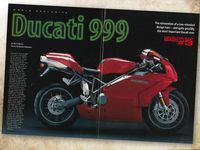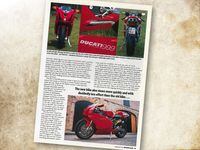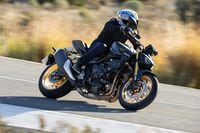Alan Cathcart
Aprilia gets aggressive with a Mille R-based naked Bike
Six months! That is all it took Aprilia to go from concept to customer for the first in a line of Tuonos. Translated into English Tuono means thunder which was the experience the team had when they looked at the finished bike, it was like a clap of thunder - hence the name. The design team was lead by former ATK mechanical engineer Klaus Nennwitz with a resume that includes the design of the Falco. He started the Tuono project just five short weeks before the Bologna Show and put most of the production work into the hands of in-house designer Guiseppe Ricciuti who produced the RSV Mille range.
The combination of engineer, designer and base machine (Mille R) was the secret to the success of such a monumental task. Once the Mille R was stripped down it was a matter of styling. Not trying to cut any corners, the Tuono retained the top of the line components including OZ wheels, Brembo brakes, and fully adjustable Ӧhlins suspension on both front and rear.
Ricciuti said “We wanted to create a mean looking, aggressive, streetfighting superbike [that] still retained the Aprilia family look, but where the quality of the materials also shone through. I think we succeeded.” - And we concur.
Ride notes:
- Same fuel delivery system components revamped to deliver more low-end and mid range power.
- Smoother response in the low end than the Mille R
- Eye popping thrust above 4000
- Especially insane thrust above 7000
- Minimal snatchiness or vibration
- Gearing - a little tall. The bike would have to be recertified for Europe to make the change. This process takes more time than was slated for this design to consume timetable set for year one of the Tuono line
- Firmly planted - Unlike most naked bikes, the Tuono does not display any wobbles or weaves
- Turn In - The tall bars offer leverage that help the bike turn in nicely
- Brakes - They are infinitely more usable than the the all-or-nothing radial package also available from Brembo on the Ducati 998R
- Cornering clearance - more than you can use [unless you a Mister 68° Marc Marquez]
- Ergo - Superb
Conclusion - There are only going to be 200 of these built [50 allegedly sent stateside] and at $17,299 you get a carbon fibre and titanium superbike that you can ride all day long. For the lucky owners who have these - hold onto them or drop them off at our offices. We’ll give them a good workout for you.
Alan Cathcart
The reinvention of a two-wheeled design icon - and quite possibly the most important Ducati ever (Development Series #3)
The 916 is aging like the Triumph Bonneville, The Porsche 911, or the Volkswagen Beetle - What do you do? The Desmoquattro line has produced 60,000 units since 1993. For many, the 916 IS Ducati. How can you follow up with that? According to Cathcart, design Chief Pierre Terblance has done more than produce an apt replacement with the new 999 but he has improved it.
The codename of this project was '97/11 which is the year and month the first Lira was spent on it’s development. One of the first impressions the author had was that although alluring, it did not grasp him the way the 916 did. Especially in a design studio on a stand. Later when photographs were taken the MC team realized that it did not photograph well in a studio setting. Especially from the side. Bring it outdoors into its intended environment, and it was infinitely more alluring and striking.
Key differences VS. the 916
- Seat - Lower and narrower in the front while offering good contact with the posterior.
- Angle is more flat to take some of the pressure off of the wrists.
- Stance - More neutral.
- Windscreen - lower and wider with enough room to get tucked into it to reduce wind noise
- Fairing - Broad and more tuned with aerodynamics in mind to reduce buffeting. Aided by the mirrors that were also used to tune the aerodynamics with buffeting in mind.
- Fuel Tank - Shape changed to put more fuel under the seat. This gave Terblance the ability to make it more narrow and help get the rider "into the bike".
- Passenger Seat - Larger pad for a more accommodating passenger experience.
- Steering - Much quicker with less oversteer and effort when you're banked deep into a turn and grab the lever.
"999's handling, which because of its revised chassis architecture, feels far better balanced than the older bike. This is especially noticeable under heavy braking, when there's definately less forward weight transfer - and thusly more stability - as you brake hard for corners, be they Monza chicanes or typical mountain road swervery." MC Note 2016 - Swervery - now that is an interesting phrase. Oddly, it wasn't in my computer's dictionary.
Besides the new look of the bike there are a number features noted during this world exclusive first look. The adjustability of the foot controls is one of the big factors offering substantial rider adjustability. The footpegs have five positions as does the foot lever itself to accommodate a range of boot sizes. Do you need to adjust the mirror while riding well, that got easier with an adjuster that should reduce the likelihood of being pitched into a ditch during this operation. Adjustability is carried over into the pilot’s saddle as well. With over an inch of forward and back movement combined with the foot controls, the perfect ergos can be achieved.
The single, under-seat silencer is being made by German firm Zuna Starker and did surely create an aftermarket for “Italian Chrome” (carbon fibre) heat shields still being bought today. Another trick adjustability designed into this new superbike is the eccentric insert in the steering head that offers a 23.5 or 24.5° head angle. Naturally, if you change the head angle you’ll need to adjust the steering damper. Terblance considered this as well and included and adjustable mount for this component.
The 999 impressed the author (Alan Cathcart) so much, his plan was to purchase one for his garage. Alan went on to state that yes, he is a fan of the Italian marque but pointed out several instances where he; in print, gave true and less than shining reviews of bikes and features of past machines. Cathcart was willing to vote for this machine with his wallet and even go a step further and state that the 999 was the best Ducati V-twin sportbike yet in a long and illustrious line.
“The best V-twin in the business just got a whole lot better, all of which means Ducati management can relax and stop worrying about the persistent nightmare of what to do with the 916. Sweet Dreams guys!”
Roland Brown
And Allen Millyard's 1600cc V-eight Kawasaki Z1 proves the point nicely...
Something only a nuclear engineer from London might conceive of is a V-eight Kawasaki 1600. Based on the KZ1000 engine and chassis along with a smattering of bits from the H2 Triple and KH250 this is exactly what Allen Milliard did. Along with the help of a few contributors from both sides of the pond, a garage full of tools including a hacksaw, a lathe and a hydraulic press he put together this one of a kind 1600 cc marvel.
Although this is a wild idea, it is not the first time he has put something like this together. Starting at the tender age of 13 he stuffed an 850cc four cylinder car engine into a 125cc BSA Bantam frame and never looked back. Other creations included a 180cc Honda V-twin created with two S90 motors in a Malaguti modped frame, and a five cylinder, 415cc Kawasaki that started life as a KH250 triple. Since then he has built several dozen such creations in configurations between two and six cylinders up to 1300cc’s.
How this motor was assembled was by starting with the stock Z1 crankcase and sawing and rewelding two top halves. But it wasn’t that simple. After some calculating and configuring Millyard decided on a 70° V. Any more pitch and there would have been interference with the clutch cog in the rear bank of cylinders and any farther forward and there would be wheelbase issues. As it was, this mad scientist added about five inches into the frame and slapped an 18” wheel into the forks as opposed to the stock 19” hoop that came standard on the Z1. This was to accommodate for the front bank of cylinders.
Although concessions were made from the stock configuration of the Z1 the intention of the craftsman was to retain as stock a look as he could. One performance concession he made was in carburetion. He estimates that sticking with one bank of (28mm Suzuki GS1100) carburetors cost him about 20 horsepower but with 140 at his disposal now, he was nonplussed by this power “loss”. Had he chosen to add an extra bank of carbs he would have had to modify the gas tank. Being one of the identifying features of the Z1 Allen decided to stick to four rather than eight carburetors.
“Most V-eight cylinders are off-line by the width of a conrod, but I didn’t want to do that because the engine would have been wider and wouldn’t have looked good or lined up right,” he says. Instead Millyard offset the cylinder liners slightly in the blocks to allow for the fact that there are two side by side conrods to each big-end. “That meant reducing the size of the pistons,” he adds. “I've ended up with 799cc per block instead of the Z1’s 903cc, and a total capacity of 1597cc.”
What came from Where?
Kawasaki Z1
- Chassis
- Gastank
- Seat
- Swingarm
- Motor (x 1.5)
Kawasaki H2
- Forks
- Wheel Hubs
- Brake Discs and Calipers
- Headlight
Kawasaki KH250
- Front Fender
Suzuki GS1100
- 28mm Carburetors
MC 2016 Observation: Looking at the work done, an untrained eye would assume this to be a period-correct restoration. The work done to put this bike together is artful. We might just have to fly over to the UK and hunt down this evil genius down and see if the purported V-12 he was thinking of building from two KZ1300 motors ever came to fruition.










/cloudfront-us-east-1.images.arcpublishing.com/octane/NTMMN7FYPHHLYH3RKVQNF7CRQA.jpg)






/cloudfront-us-east-1.images.arcpublishing.com/octane/OKWOJWAKP5EP3OACCRRWPCIX2Q.jpg)
/cloudfront-us-east-1.images.arcpublishing.com/octane/2WF3SCE3NFBQXLDNJM7KMXA45E.jpg)
/cloudfront-us-east-1.images.arcpublishing.com/octane/G4MG6OUCJNBSHIS2MVVOTPX65E.jpg)
/cloudfront-us-east-1.images.arcpublishing.com/octane/IIGGWFOTOJGB7DB6DGBXCCMTDY.jpg)
/cloudfront-us-east-1.images.arcpublishing.com/octane/QSTCM6AVEZA5JJBUXNIQ3DSOF4.jpg)
/cloudfront-us-east-1.images.arcpublishing.com/octane/U4I7G625B5DMLF2DVIJDFZVV6M.jpg)
/cloudfront-us-east-1.images.arcpublishing.com/octane/B6XD6LS6IVCQPIU6HXDJSM3FHY.jpg)
/cloudfront-us-east-1.images.arcpublishing.com/octane/ICL63FEDDRDTTMINYICCEYGMDA.jpg)
/cloudfront-us-east-1.images.arcpublishing.com/octane/FCGZHQXRBZFLBAPC5SDIQLVF4I.jpg)
/cloudfront-us-east-1.images.arcpublishing.com/octane/WNOB6LDOIFFHJKPSVIWDYUGOPM.jpg)

/cloudfront-us-east-1.images.arcpublishing.com/octane/X33NU3E525ECRHXLNUJN2FTRKI.jpg)
/cloudfront-us-east-1.images.arcpublishing.com/octane/6KKT5NNL2JAVBOXMZYS5ZO76YA.jpg)
/cloudfront-us-east-1.images.arcpublishing.com/octane/J5RKG5O455GMPGQRF2OG6LRT7A.jpg)
/cloudfront-us-east-1.images.arcpublishing.com/octane/GX2CIZKQVRH2TATDM26KFG2DAE.jpg)
/cloudfront-us-east-1.images.arcpublishing.com/octane/ZWIDYSAKQZHD5BHREMQILXJCGM.jpg)
/cloudfront-us-east-1.images.arcpublishing.com/octane/CYUHJZCTSJCH3MRAQEIKXK7SCQ.jpg)
/cloudfront-us-east-1.images.arcpublishing.com/octane/LKOFINY56FCXJCANJ5M7ZDQUBY.jpg)
/cloudfront-us-east-1.images.arcpublishing.com/octane/4NBPDACMWJH63JQYJVK3QRBDZI.jpg)
/cloudfront-us-east-1.images.arcpublishing.com/octane/KKHQHRR3FJGX7H2IPU6RALMWG4.jpg)

/cloudfront-us-east-1.images.arcpublishing.com/octane/5IOFS5JAE5FOXMNA23ZRAVVYUU.jpg)
/cloudfront-us-east-1.images.arcpublishing.com/octane/CGXQ3O2VVJF7PGTYR3QICTLDLM.jpg)
